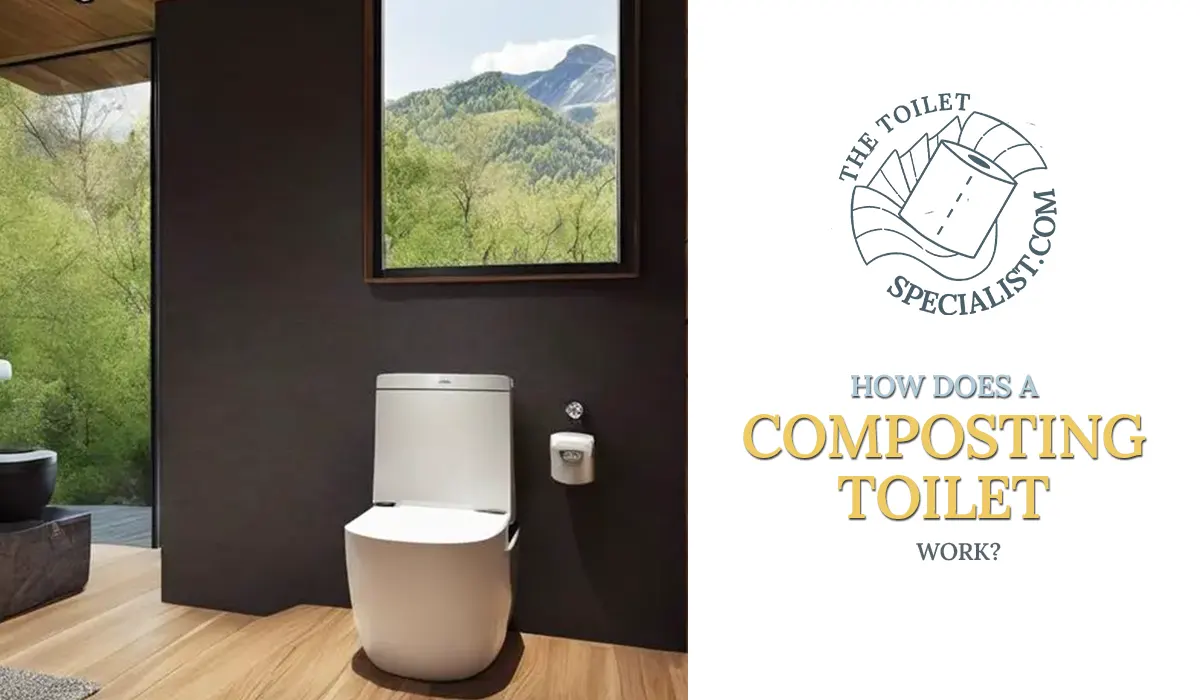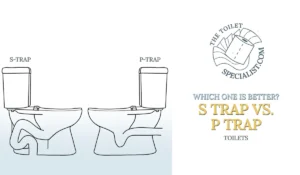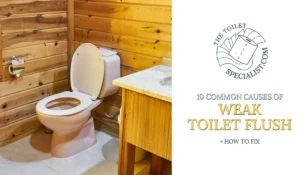You probably have heard of a low flow toilet. Or a toilet with low GPF. But did you know there’s another way to go green toilet wise. You can compost your own waste!
A composting toilet works by utilizing two compartments one for urine and another for solid waste. Organic material aids with the composting of human waste. Ventilation systems reduce odors, and the aerobic decomposition process turns waste into nutrient-rich compost. This then can be safely disposed of or used as fertilizer. These toilets are eco-friendly solutions and suitable for remote locations.
But did you know that you can have a modern toilet that composts inside your home? Find out what a composting toilet is, its advantages and limitations, as well as installation and maintenance best practices to help you explore a greener lifestyle.
What is a composting toilet?
A far cry from the traditional flush toilets we’ve become accustomed to, these innovative waste-handling systems offer an ecology-friendly solution to waste management. Plus, there low-budget ones, and more expensive (but still popular) ones.
A composting toilet is a type of toilet that uses natural processes to decompose human waste, converting it into nutrient-rich compost. Unlike traditional flush toilets, composting toilets don’t use water for flushing. They typically have separate compartments for liquid and solid waste. Solid waste is mixed with organic material like sawdust or coconut coir, facilitating decomposition.
This means it efficiently breaks down waste in the presence of oxygen, converting it into a nutrient-rich soil conditioner. This is all facilitated by bacteria, fungi and other microorganisms that are naturally present in human waste.
Composting toilet works in 3 stages
The functioning of a composting toilet involves three stages: composting, storage, and disposal. During the composting stage, the waste material is stored in a chamber under the toilet, where it is broken down by microorganisms. This process subjects the waste material to high temperatures, effectively eliminating harmful viruses and bacteria, and turning it into compost.
The compost produced is stored within the unit for a stipulated period until it is safe for handling and disposal. This compost can then be used as an excellent soil additive for gardening. Depending on the toilet, expect to empty it once every 3-4 weeks.
A properly managed composting toilet can reduce up to half the total volume of waste, resulting in a decrease in water consumption and an environmentally friendly toilet option. Opting for a composting toilet is essentially choosing a sustainable solution that benefits both homeowners and the environment.
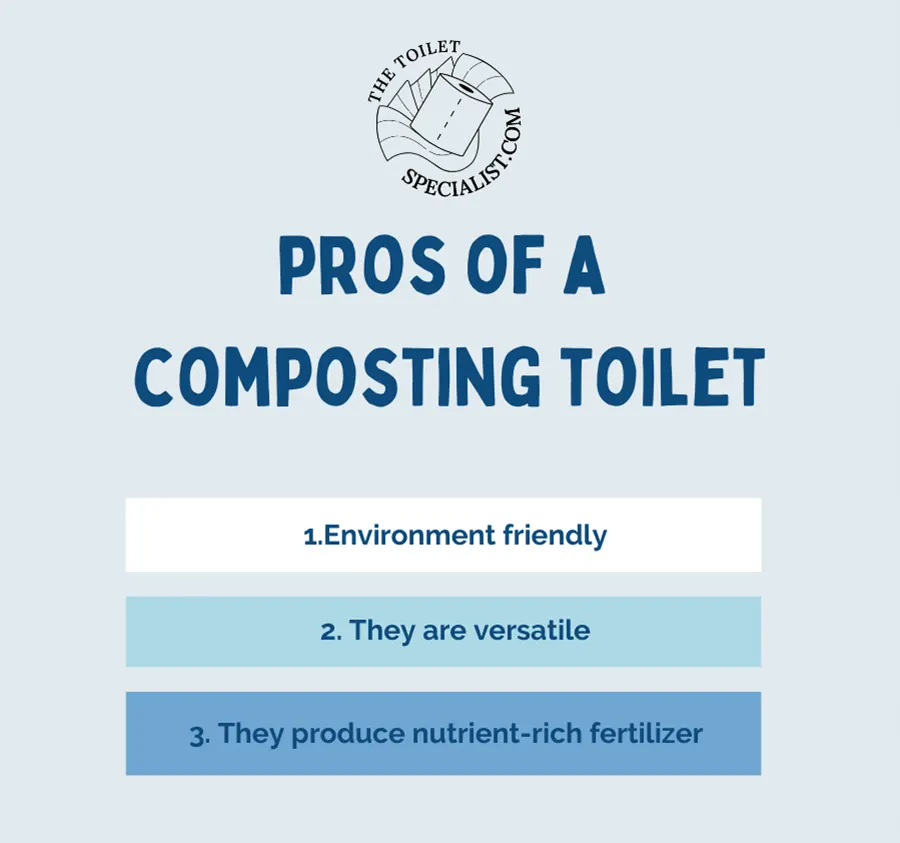
Pros and cons of a Composting Toilet
Composting toilets represent a revolutionary pivot in sustainable living solutions. A pertinent advantage of opting for a composting toilet lies in its economic benefits.
Pros of a composting toilet
A pertinent advantage of opting for a composting toilet lies in its economic benefits.
A typical flush toilet uses a significant amount of water – an estimated 1.6 gallons per flush, which does add up. Conversely, a composting toilet uses a fraction of this, effectively lowering water bills, making it a pocket-friendly choice for homeowners.
Plus, an added feature that may appeal to those based in off-grid or remote locations is that composting toilets don’t require connection to sewage systems.
Cons of a composting toilet
Nonetheless, there are notable potential drawbacks to consider before you decide to invest in a composting toilet.
Firstly, they necessitate careful and regular maintenance to ensure optimal function. Without regular attention, toilets could emit unpleasant odors or even overflow, causing health hazards.
Moreover, composting toilets require occasional emptying, depending on usage and the specific model – this can be a messy task that not everyone might be comfortable undertaking.
Additionally, there may be pitfalls involving local regulations, with some areas having strict rules regarding the use and installation of composting toilets.
Moreover, switching from a conventional flush toilet to a composting one might represent a considerable outlay initially, despite the later savings on water costs.
Above all, the successful operation of a composting toilet demands a genuine commitment to sustainable practices, making it less effective for those not fully invested in eco-conscious living.
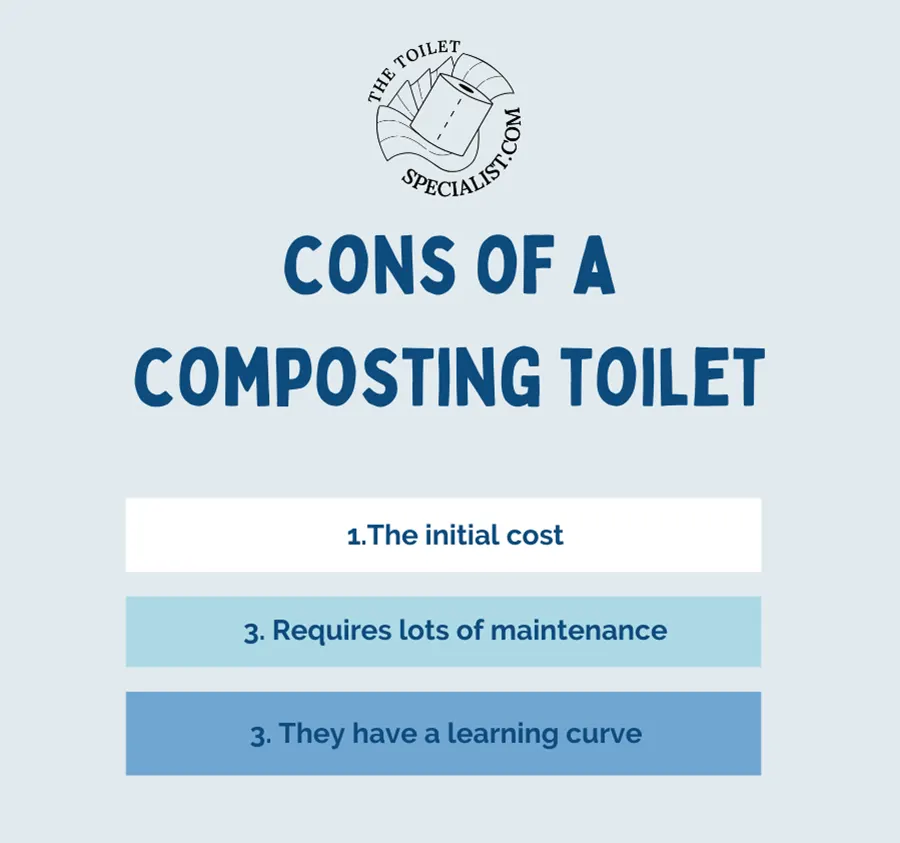
Types of composting toilets
There sure are different kinds:
- Self-Contained Unit
- These compact composting toilets integrate the composting chamber and waste collection within a single unit. They are suitable for small spaces and often used in off-grid cabins or tiny houses.
- Centralized Systems
- Larger composting toilet systems separate waste collection from the composting unit, allowing for multiple toilets to be connected to a central composting chamber. This type is common in communal or commercial settings.
- Electric vs. Non-Electric
- Composting toilets can be electrically powered, featuring fans for ventilation, or non-electric, relying on natural ventilation. Electric models are common in residential settings, while non-electric options are suitable for off-grid or remote locations.
- Batch Systems
- These toilets accumulate waste in batches, allowing one chamber to compost while the other is in use. After a certain period, users switch to the other chamber, providing time for complete composting.
- Continuous Systems
- In continuous composting toilets, waste is added consistently, and composting occurs simultaneously. These systems often have rotating drums or agitators to aid in the composting process.
- Mobile/Portable Toilets
- Designed for temporary use, these composting toilets are often lightweight and portable, making them suitable for camping, outdoor events, or construction sites.
Installing and Maintaining a Composting Toilet
Taking the plunge to install a composting toilet system in your home begins with careful planning. The installation usually involves securing the composting toilet to the floor, connecting the vent stack to the toilet, and setting up connections for urine diversion if the model requires it. With the necessary tools and following the manufacturer’s instructions, the installation can be a successful DIY project.
Once installed, it’s crucial to commit to maintaining your system for efficient operation. Use a bulking agent like sawdust, peat moss, or coconut coir, which aids in waste breakdown and controls odor by adding structure to the compost. This should be added after each use, along with turning the compost periodically (if your model requires it) to ensure even decomposition.
How do you empty a composting toilet?
To empty a composting toilet you start by preparing with personal protective equipment such as gloves and a mask. Turn off any ventilation fans to minimize odors, then open the access door to the compost chamber. If applicable, remove the container for liquid waste and empty it separately. Use a designated tool or scoop to remove the solid composted material, placing it in a compost bin.
Add a layer of bulking material for the next cycle, and clean and disinfect the interior of the composting chamber. Close the access door securely, turn the ventilation back on, and dispose of the composted material according to local regulations—either on your property or in a designated waste facility.
Always follow the manufacturer’s instructions for your specific composting toilet model, as procedures may vary. This general guide aims to provide an overview, but specific details and recommendations should be followed for the safe and effective management of your composting toilet.
Do composting toilets smell?
Composting toilets are designed to minimize and control odors through proper ventilation and the composting process. When operated correctly, composting toilets should not produce offensive smells associated with traditional sewage systems. The key to odor control lies in maintaining the balance of organic material (human waste, toilet paper) with bulking agents like sawdust or coconut coir.
These agents help create an aerobic environment that promotes the decomposition of waste without generating unpleasant odors.
What do you do with the urine from a composting toilet?
The urine from a composting toilet is typically diverted separately from solid waste. Many composting toilet systems have a separate collection container or divert the urine to a designated outlet. This separation helps in managing the composting process more effectively. The collected urine can be disposed of in various ways, depending on local regulations and personal preferences.
Other green choices to accompany your composting toilet
Choosing sustainable toilet paper, like this popular one, can contribute to smoother composting. Regular inspection of the compost pile will help assess when it’s ready to be removed, which usually takes a few months to a couple of years depending on usage and composting conditions. After removal, the compost should be used for non-food plants to ensure safety, or be left to age further for up to two years to kill off potential harmful pathogens.
Remember, optimal maintenance is necessary to reap the environmental and economic benefits of your composting toilet. With proper commitment and care, a composting toilet can be a sustainable, rewarding choice for your home.
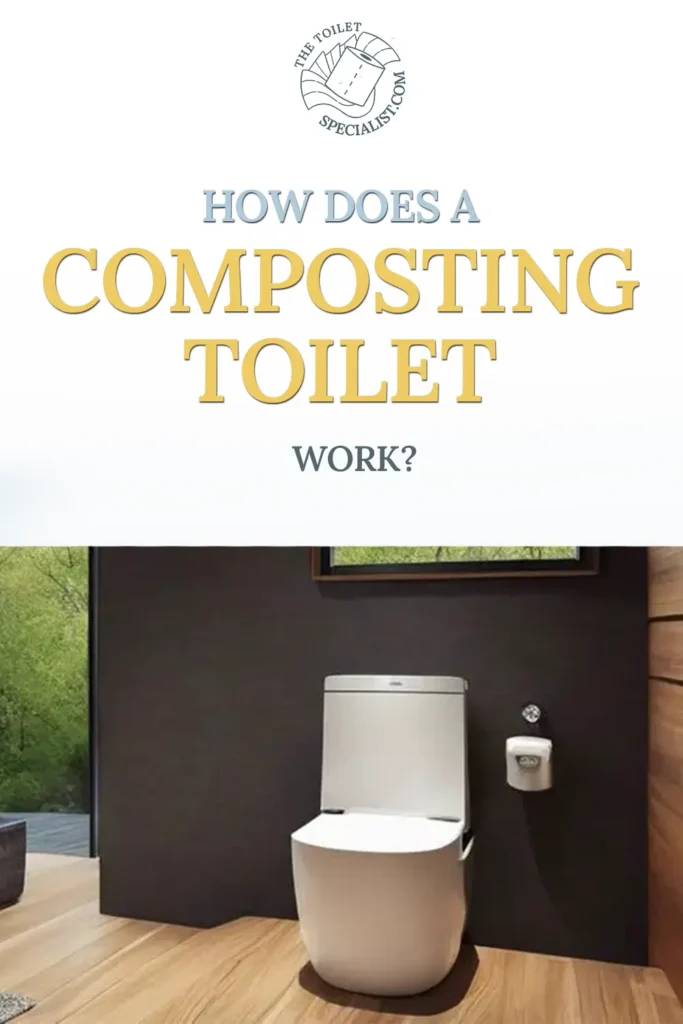
Exploring alternative methods of waste management such as composting toilets shines a light on the potential for adopting more eco-friendly practices in our everyday lives. They urge us to rethink not just how we view waste, but also how our choices can benefit both us and the planet.
Armed with knowledge of what a composting toilet is, the pros and cons of its use, and guidance on installing and maintaining one, you can consider if it’s a fit for your lifestyle. While it may require a few adjustments, taking the leap can leave a positive impact on water conservation efforts, and contribute significantly to a sustainable and eco-friendly lifestyle.
Disclaimer: TheToiletSpecialist.com is not responsible for any damage caused to your toilet and surroundings by (wrongly) interpreting information found on this site. Please seek custom advice from a professional to evaluate your current situation.
This article may contain affiliate links at no extra cost to you. AF links help support this blog so that it can exist and expand for years to come!

